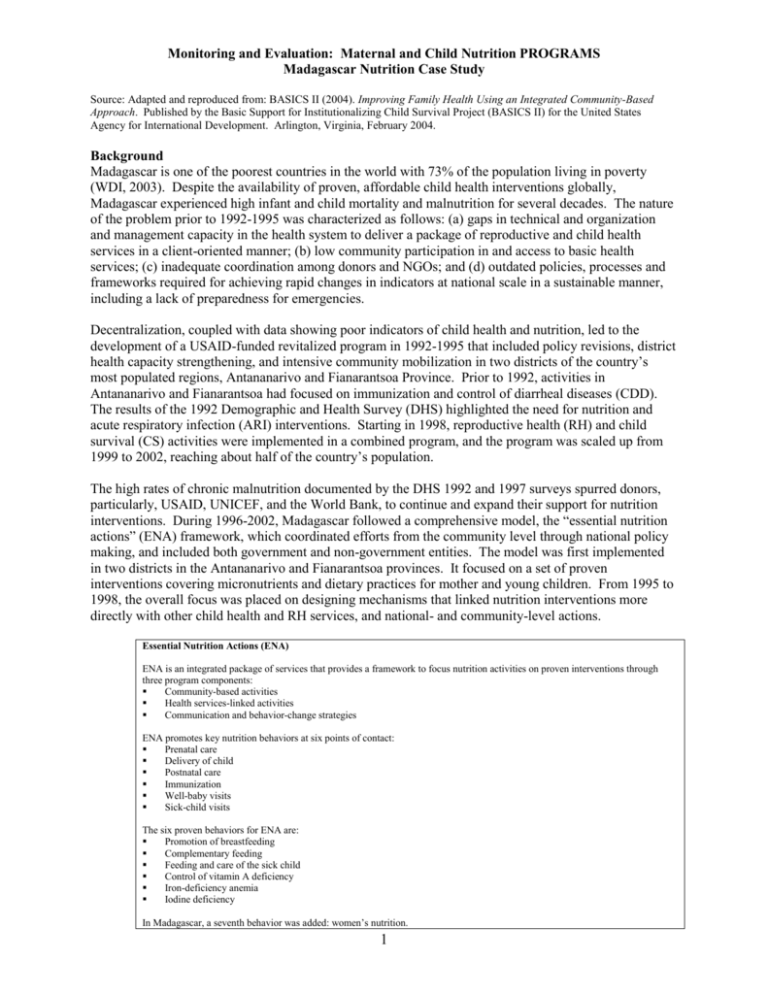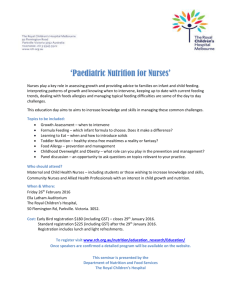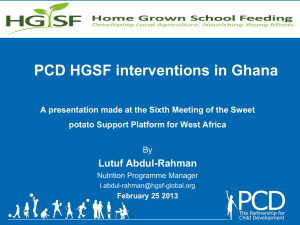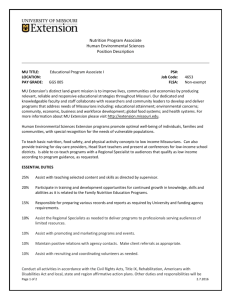Madagascar Nutrition
advertisement

Monitoring and Evaluation: Maternal and Child Nutrition PROGRAMS Madagascar Nutrition Case Study Source: Adapted and reproduced from: BASICS II (2004). Improving Family Health Using an Integrated Community-Based Approach. Published by the Basic Support for Institutionalizing Child Survival Project (BASICS II) for the United States Agency for International Development. Arlington, Virginia, February 2004. Background Madagascar is one of the poorest countries in the world with 73% of the population living in poverty (WDI, 2003). Despite the availability of proven, affordable child health interventions globally, Madagascar experienced high infant and child mortality and malnutrition for several decades. The nature of the problem prior to 1992-1995 was characterized as follows: (a) gaps in technical and organization and management capacity in the health system to deliver a package of reproductive and child health services in a client-oriented manner; (b) low community participation in and access to basic health services; (c) inadequate coordination among donors and NGOs; and (d) outdated policies, processes and frameworks required for achieving rapid changes in indicators at national scale in a sustainable manner, including a lack of preparedness for emergencies. Decentralization, coupled with data showing poor indicators of child health and nutrition, led to the development of a USAID-funded revitalized program in 1992-1995 that included policy revisions, district health capacity strengthening, and intensive community mobilization in two districts of the country’s most populated regions, Antananarivo and Fianarantsoa Province. Prior to 1992, activities in Antananarivo and Fianarantsoa had focused on immunization and control of diarrheal diseases (CDD). The results of the 1992 Demographic and Health Survey (DHS) highlighted the need for nutrition and acute respiratory infection (ARI) interventions. Starting in 1998, reproductive health (RH) and child survival (CS) activities were implemented in a combined program, and the program was scaled up from 1999 to 2002, reaching about half of the country’s population. The high rates of chronic malnutrition documented by the DHS 1992 and 1997 surveys spurred donors, particularly, USAID, UNICEF, and the World Bank, to continue and expand their support for nutrition interventions. During 1996-2002, Madagascar followed a comprehensive model, the “essential nutrition actions” (ENA) framework, which coordinated efforts from the community level through national policy making, and included both government and non-government entities. The model was first implemented in two districts in the Antananarivo and Fianarantsoa provinces. It focused on a set of proven interventions covering micronutrients and dietary practices for mother and young children. From 1995 to 1998, the overall focus was placed on designing mechanisms that linked nutrition interventions more directly with other child health and RH services, and national- and community-level actions. Essential Nutrition Actions (ENA) ENA is an integrated package of services that provides a framework to focus nutrition activities on proven interventions through three program components: Community-based activities Health services-linked activities Communication and behavior-change strategies ENA promotes key nutrition behaviors at six points of contact: Prenatal care Delivery of child Postnatal care Immunization Well-baby visits Sick-child visits The six proven behaviors for ENA are: Promotion of breastfeeding Complementary feeding Feeding and care of the sick child Control of vitamin A deficiency Iron-deficiency anemia Iodine deficiency In Madagascar, a seventh behavior was added: women’s nutrition. 1 Delivery strategies and approaches used to implement the interventions included the following: High frequency and intensity of behavior change communication (BCC) activities through multiple channels Training of health workers in clinical and counseling skills, interpersonal communications, and supervision; Use of “negotiation” techniques to change household behaviors. The negotiation technique that underlies the Trial for Improved Practices (TIPS) method has been streamlined and forms the foundation of promoting optimal health practices Support for community-based organizations and individuals. Expanded support is given to community leaders, community volunteers, and women’s groups, and includes training in village theater and (interpersonal) counseling; Orientation/training on how to integrate essential actions into existing MCH services. This specific training was provided to front-line health workers; Important links forged from district to national-level organizations. Connections were made at the national level to assure that policies and coordinating mechanisms were in place among partners that were involved in nutrition; Advocacy using PROFILES, a data-based presentation quantifying the benefits and costs of nutrition actions. It was used to inform audiences ranging from community leaders to national lawmakers. A broad-based multi-sectoral campaign was undertaken to raise awareness; Invocation of mass media and communications. This large campaign included radio, television, festivals, print media, and the use of celebrities to promote targeted messages; and Systems strengthening. This push involved supplies, monitoring and evaluation, rapid assessments, training, and pre-service education. Specific Messages Tailored Around Seven Behaviors of ENA in Madagascar Exclusive Breastfeeding (EBF) to 6 months Earlier initiation of BF Exclusive BF until 6 months BF day and night, until at least 10 months Correct positioning and attachment Empty one breast and switch to the other Complementary Feeding Plus Breastfeeding (BF) from 6 to 24 Months Continue BF until 24 months and more Increase the number of feedings with age Increase density, quantity and variety with age Responsive feeding Food hygiene Control of Vitamin A Deficiency BF as a source of vitamin A Vitamin A-rich foods Child supplementation Food fortification Consumption of iodized salt (IS): Access to IS and consumption by all families Control of Anemia Supplementation for women and children (IMCI) De-worming for pregnant women and children (twice a year) Malaria control Iron-rich food Fortification Women’s Nutrition During pregnancy and lactation (increase feeding) Iron/folic acid supplementation, treatment and prevention of malaria De-worming during pregnancy Vitamin A capsule after delivery 2 Feeding of Sick Child Increase BF and complementary feeding during and after illness Use of IMCI protocols for case management, including nutritional assessments ASSIGNMENT Divide the class into three groups: - Group 1: Behavior-change communication (BCC) - Group 2: Health-worker training - Group 3: Integration of ENA into MCH services GROUP 1 1. Develop a logical framework for monitoring and evaluating BCC component of the nutrition program. 2. Propose a set of indicators for monitoring and evaluating BCC activities. 3. Choose one proposed output indicator and one proposed outcome indicator. For each indicator, identify the numerator and denominator, data sources, as well as the indicator’s strengths and limitations. GROUP 2 1. Develop a logical framework for monitoring and evaluating the health worker training component of the nutrition program. 2. Propose a set of indicators for monitoring and evaluating the health worker training activities. 3. Choose one proposed output indicator and one proposed outcome indicator. For each indicator, identify the numerator and denominator, data sources, as well as indicator’s strengths and limitations. GROUP 3 1. Develop a logical framework for monitoring and evaluating the integration of ENA into MCH services. 2. Propose a set of indicators for monitoring and evaluating the integration efforts. 3. Choose one proposed output indicator and one proposed outcome indicator. For each indicator, identify the numerator and denominator, data sources, as well as indicator’s strengths and limitations. 3







